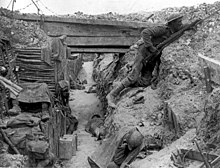Western Front (World War I)
The Western Front was started by the German Army invading Luxembourg and Belgium at the beginning of World War I in 1914 and gaining military control of many important industrial regions in France. Its quick advance was stopped by the Battle of the Marne. Both sides then dug defensive trenches, which eventually reached from the North Sea to the Swiss border with France.
| Western Front | |||||||
|---|---|---|---|---|---|---|---|
| Part of World War I | |||||||
 For most of World War I, Allied and German Forces were stalled in trench warfare along the Western Front. This picture shows a sentry of A Company, 11th Battalion, The Cheshire Regiment in a trench during the Battle of the Somme. | |||||||
| |||||||
| Belligerents | |||||||
| |||||||
| Commanders and leaders | |||||||
| No unified command until 1918, then Ferdinand Foch | Moltke → Falkenhayn → Hindenburg and Ludendorff → Hindenburg and Groener | ||||||
| Casualties and losses | |||||||
| ~4,800,000 | Unknown | ||||||
From 1915 to 1917, many offensives were started from the trenches. Both sides used large numbers of artillery and thousands of infantry in the offensives. However, a combination of entrenchments, machine gun nests, barbed wire, and artillery stopped the advances. No major breakthroughs happened.
New military technology, like poison gas, aircraft, and tanks were developed to try and get through the lines of trenches.
The deadlock was caused mostly by both sides not allowing any piece of land to give some kind of advantage to the enemy, even if there was little advantage. As the war continued, and more blood was lost on both sides, the soldiers grew tired of war and had begun to make large threats to the government.
To keep the war effort going, the governments began to say that they would kill soldiers who did not attack and that the soldiers betrayed the army if they did not fight.